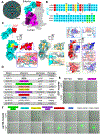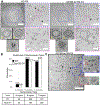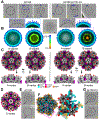Structure-guided mutagenesis targeting interactions between pp150 tegument protein and small capsid protein identify five lethal and two live-attenuated HCMV mutants
- PMID: 38805802
- PMCID: PMC11260070
- DOI: 10.1016/j.virol.2024.110115
Structure-guided mutagenesis targeting interactions between pp150 tegument protein and small capsid protein identify five lethal and two live-attenuated HCMV mutants
Abstract
Human cytomegalovirus (HCMV) replication relies on a nucleocapsid coat of the 150 kDa, subfamily-specific tegument phosphoprotein (pp150) to regulate cytoplasmic virion maturation. While recent structural studies revealed pp150-capsid interactions, the role of specific amino-acids involved in these interactions have not been established experimentally. In this study, pp150 and the small capsid protein (SCP), one of pp150's binding partners found atop the major capsid protein (MCP), were subjected to mutational and structural analyses. Mutations to clusters of polar or hydrophobic residues along the pp150-SCP interface abolished viral replication, with no replication detected in mutant virus-infected cells. Notably, a single amino acid mutation (pp150 K255E) at the pp150-MCP interface significantly attenuated viral replication, unlike in pp150-deletion mutants where capsids degraded outside host nuclei. These functionally significant mutations targeting pp150-capsid interactions, particularly the pp150 K255E replication-attenuated mutant, can be explored to overcome the historical challenges of developing effective antivirals and vaccines against HCMV infection.
Keywords: Capsid; HCMV; Replication; Structure; Tegument.
Copyright © 2024 The Authors. Published by Elsevier Inc. All rights reserved.
Conflict of interest statement
Declaration of competing interest The authors declare that they have no known competing financial interests or personal relationships that could have appeared to influence the work reported in this paper.
Figures




Update of
-
Structure-Guided Mutagenesis Targeting Interactions between pp150 Tegument Protein and Small Capsid Protein Identify Five Lethal and Two Live Attenuated HCMV Mutants.bioRxiv [Preprint]. 2024 Apr 5:2024.01.22.576707. doi: 10.1101/2024.01.22.576707. bioRxiv. 2024. Update in: Virology. 2024 Aug;596:110115. doi: 10.1016/j.virol.2024.110115. PMID: 38328201 Free PMC article. Updated. Preprint.
Similar articles
-
Structure-Guided Mutagenesis Targeting Interactions between pp150 Tegument Protein and Small Capsid Protein Identify Five Lethal and Two Live Attenuated HCMV Mutants.bioRxiv [Preprint]. 2024 Apr 5:2024.01.22.576707. doi: 10.1101/2024.01.22.576707. bioRxiv. 2024. Update in: Virology. 2024 Aug;596:110115. doi: 10.1016/j.virol.2024.110115. PMID: 38328201 Free PMC article. Updated. Preprint.
-
The smallest capsid protein mediates binding of the essential tegument protein pp150 to stabilize DNA-containing capsids in human cytomegalovirus.PLoS Pathog. 2013 Aug;9(8):e1003525. doi: 10.1371/journal.ppat.1003525. Epub 2013 Aug 15. PLoS Pathog. 2013. PMID: 23966856 Free PMC article.
-
Atomic structures and deletion mutant reveal different capsid-binding patterns and functional significance of tegument protein pp150 in murine and human cytomegaloviruses with implications for therapeutic development.PLoS Pathog. 2019 Feb 19;15(2):e1007615. doi: 10.1371/journal.ppat.1007615. eCollection 2019 Feb. PLoS Pathog. 2019. PMID: 30779794 Free PMC article.
-
Exploiting the chikungunya virus capsid protein: a focused target for antiviral therapeutic development.Arch Virol. 2025 May 27;170(7):141. doi: 10.1007/s00705-025-06325-2. Arch Virol. 2025. PMID: 40423856 Review.
-
The human cytomegalovirus nuclear egress complex unites multiple functions: Recruitment of effectors, nuclear envelope rearrangement, and docking to nuclear capsids.Rev Med Virol. 2017 Jul;27(4). doi: 10.1002/rmv.1934. Epub 2017 Jun 30. Rev Med Virol. 2017. PMID: 28664574
Cited by
-
Structure of a new capsid form and comparison with A-, B- and C-capsids clarify herpesvirus assembly and DNA translocation.bioRxiv [Preprint]. 2025 May 8:2025.03.19.644230. doi: 10.1101/2025.03.19.644230. bioRxiv. 2025. Update in: J Virol. 2025 Jul 22;99(7):e0050425. doi: 10.1128/jvi.00504-25. PMID: 40166288 Free PMC article. Updated. Preprint.
-
Structure of a new capsid form and comparison with A-, B-, and C-capsids clarify herpesvirus assembly.J Virol. 2025 Jul 22;99(7):e0050425. doi: 10.1128/jvi.00504-25. Epub 2025 Jul 3. J Virol. 2025. PMID: 40607812 Free PMC article.
References
-
- Adler SP, Lewis N, Conlon A, Christiansen MP, Al-Ibrahim M, Rupp R, Fu T-M, Bautista O, Tang H, Wang D, Fisher A, Culp T, Das R, Beck K, Tamms G, Musey L, Group V-S, 2019. Phase 1 clinical trial of a conditionally replication-defective human cytomegalovirus (CMV) vaccine in CMV-seronegative subjects. J. Infect. Dis 220, 411–419. - PubMed
Publication types
MeSH terms
Substances
Grants and funding
LinkOut - more resources
Full Text Sources
Miscellaneous

